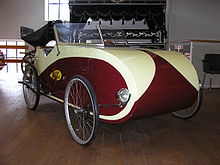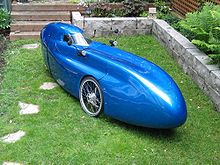Velomobile

A velomobile ( suitcase word from French and Swiss German: “vélo” - bicycle and mobile based on “ automobile ”) is a muscle-powered vehicle that is equipped with a closed fairing ( streamlined fairing ) that protects the driver from the wind and rain. Velomobiles are often developed from recumbent tricycles and therefore usually have three wheels.
In terms of purpose and design, velomobiles are usually designed to be much more sporty than rickshaws , for example ; besides, they are light . Motor support is often possible.
Design and construction
Some velomobiles are fully encased recumbent tricycles that can also be driven without a casing. These include the / the Leitra ( Le ichter i ndividueller Tra nSports, since 1980, built by Carl Georg Rasmussen (* 1935)) and the Thunder Storm. Most velomobiles, however, have a lightweight monocoque construction made of GRP and CFRP . The Alleweder , on the other hand, has a monocoque made of riveted aluminum sheets.
Velomobiles are manufactured both completely closed and in a half-open design. With the latter, the driver's head is in the open. In practice, the two designs differ primarily in terms of weather protection, air resistance and visibility in rain and snow. Some velomobiles have removable hoods so that they can be driven both open and closed. In principle, all velomobiles can also be equipped with an electric motor.
The empty weight of commercially available velomobiles is generally between 20 and 40 kg. Velomobiles are single-seaters with the exception of a few. In order to keep air resistance low, great attention is paid to a good streamlined shape in modern velomobiles . They usually have three wheels, the so-called Tadpole design with two front wheels and one rear wheel being the most common.
Fully encased recumbents with two wheels are generally not referred to as velomobiles, but rather as streamliners. Streamliners can be seen almost exclusively in races and record drives, as they are significantly more sensitive to crosswinds than a multi-lane vehicle. Fully encased recumbents for record drives don't even have holes for the feet, so starting and stopping is only possible with outside help.
Four-wheeled velomobiles are rare because, with their slightly higher weight and wind resistance, they are slower compared to three-wheeled constructions, but they offer better cornering behavior and (like the Quattrovelo) more storage space. In addition, the driving behavior remains easily controllable even if the rear wheel bursts, while a rear tire burst can quickly lead to loss of control in three-wheeled velomobiles and at higher speeds. Velomobiles can reach speeds of 70–100 km / h even on moderate slopes.
With the fully faired Vector recumbent trike, a rider achieved 100 km / h on a bike for the first time in 1986 - with muscle power, on the flat without slipstream.
Advantages and disadvantages compared to cycling
Velomobile speed advantages are primarily based on the significantly lower air resistance , which results from a low drag coefficient and the smaller frontal area compared to classic bicycles. CW * A values of 0.09 are achieved as an example. Velomobiles are therefore clearly superior to classic bicycles with the same strong driver in terms of the maximum and travel speeds that can be achieved.
If, for example, around 24 km / h can be achieved on a Dutch bike with 180 W, a velomobile with the same output will achieve 44 km / h.
However, this advantage is only noticeable on level ground and on slopes, because the higher weight becomes the dominant factor when accelerating and on inclines. With an appropriately designed gear shift, however, inclines can also be mastered. At very low speeds, three-wheeled velomobiles are also more stable than two-wheelers, which have to be constantly balanced. B. do not tip over on a smooth surface.
Their low distribution can also be explained by their high price - for example, the Alleweder as a kit starts at around 2700 euros; Cab bike from around 4600 euros. So far, velomobiles have only been built by hand in small series. The conception of an inexpensive, everyday-oriented velomobile as well as possible strategies to achieve the quantities necessary for mass production were the subject of the RegInnoMobil research project.
A major advantage over bicycles (without a trailer) is the larger storage space, which can be locked and cannot be seen from the outside. A modular extension analogous to the bicycle with saddlebags, low riders, rucksacks, baskets or trailers is usually not provided.
Because of their higher weight and larger dimensions, velomobiles are more difficult to store in the bicycle cellar than conventional bicycles and are also difficult to transport over stairs. Transports by rail are therefore mostly not possible, or only occasionally in special wagon types.
Everyday and weather suitability
Compared to conventional bicycles , closed velomobiles offer excellent weather protection from wind, rain, snow, hail and cold. They can usually be driven without rain gear. In velomobiles, where the rider's head is exposed to the wind, a hat or helmet is required. As an alternative to this, the manufacturer of the Versatile , for example, offers a light, semi-open and foldable roof that can also be mounted on many other open velomobiles. Most velomobiles can largely be described as all-weather year-round vehicles. Restrictions apply to driving in snow, as the traction of the drive wheel decreases significantly here. From a certain snow depth onwards , the casing can also come on. Overcoming snow obstacles is problematic, and inadequate paths can also be a challenge.
The heat produced by the physical exertion is sufficient to ensure a comfortable temperature inside the casing. Most velomobiles also offer storage space for small to medium-sized transports of luggage or purchases, so that the vehicles can be used in various everyday situations. Ventilation is a decisive factor in the suitability of a velomobile for everyday use. If sufficient ventilation is not guaranteed on a velomobile, the windows will fog up and visibility may be severely impaired. Otherwise, condensation can form in the interior, which can even lead to puddles in the mostly closed floor pans. In summer temperatures from 30 degrees upwards, velomobiles with a poor cooling concept heat up strongly. On the other hand, with closed velomobiles without large windows, the driver is spared the heat of the sun. Well-functioning airflow cooling is an important feature in the design of these vehicles.
Environmental protection and relationship with motor vehicles
Compared to cars , velomobiles can be seen as environmentally friendly, low-energy means of transport for everyday use. Electric drives to supplement muscle power are sometimes offered for an extra charge or can be retrofitted as with conventional bicycles. Converting to a so-called pedelec is comparatively easy ; here the motor only provides pedal assistance, which ends above 25 km / h. If a velomobile is equipped with a motor that allows it to be driven without pedaling, or enables pedal assistance up to 45 km / h, the vehicle is subject to insurance; the approval of such a drive as a single conversion is extremely complex and expensive. Some manufacturers offer the vehicles then S-pedelec mentioned that an insurance plate as mopeds or mopeds must wear, at the factory. In Germany, unlike pedelecs, S-Pedelecs are no longer considered bicycles, but are classified as light mopeds according to the Federal Motor Transport Authority. Therefore, they may ![]() not be used on cycle paths in urban areas without the “Moped free” sign ( ). Outside built-up areas, S-Pedelecs, as well as mopeds, are allowed to use cycle paths. Since an amendment to the law in 2009, it has been controversial whether mopeds - and thus also S-Pedelecs - may or must use so-called mandatory cycle paths (signs 237
not be used on cycle paths in urban areas without the “Moped free” sign ( ). Outside built-up areas, S-Pedelecs, as well as mopeds, are allowed to use cycle paths. Since an amendment to the law in 2009, it has been controversial whether mopeds - and thus also S-Pedelecs - may or must use so-called mandatory cycle paths (signs 237 ![]() , 240
, 240 ![]() and 241
and 241 ![]() ) when the drive is switched off .
) when the drive is switched off .
safety
The low prevalence of velomobiles does not allow any statistically verifiable statements about safety.
The driving stability of three-wheeled velomobiles is primarily determined by the track width and height of the vehicle's center of gravity. The majority of velomobiles are sufficiently stable. However, as practice shows, velomobiles are not immune to tipping over either. The body of velomobiles cannot be compared with modern passenger cells of motor vehicles. The mostly very light casings offer a little protection in the event of a collision. In the case of velomobiles made of fiber-reinforced plastics, however, splintering of the material can cause injuries. Some manufacturers, such as For example, the Czech manufacturer Katanga at WAW therefore offers their velomobile with a break-proof and splinter-proof layer of aramid fabric on the inside of the body.
One advantage of velomobiles is the lying position of the rider. A collision with an obstacle coming from the front takes place first with the feet and not with the head. In the event of minor accidents, this also prevents the rider from falling off the bike. Falls are the main cause of injuries on normal, bare bicycles. It can be seen positively that, in the event of an accident, the cladding can prevent, or at least significantly reduce, injuries from direct contact with the road or a light opponent. The mostly low seat height reduces the driver's overview, there are no seatbelts, and most designs lack special head protection or roll bars.
See also
Web links
- Velomobile seminars online (resources available for free download, mainly in English with some German-language materials)
- Velomobile - model overview in the wiki of the Velomobilforum.de
- Velomobile basic knowledge (html) - an extensive compilation of frequently asked questions and related answers ( PDF and ePub )
Individual evidence
- ↑ http://www.hpv.org/index.php/hpv-blog/452-in-eigener-sache-carl-georg-rasmussen-wurde-80-jahre-alt On my own account: Carl Georg Rasmussen was 80 years old old. HPV D Blog, July 16, 2015. Retrieved August 2, 2015.
- ↑ HPV Chronicle 25 years issuu.com, HPVD, Andreas Posch, 2010, p. 10. (picture, IFMA 1986, without full cover) accessed December 2, 2017. -
- ^ History recumbent bike ( memento from August 11, 2018 in the Internet Archive ) liegeradclub-vorarlberg.co.at, accessed December 2, 2017. - "1986 Vector 100 km / h"
- ↑ kreuzotter.de: Speed and power on bicycles , accessed April 23, 2020
- ↑ Price list All neither as a battery-powered bike. alleweder.de, status 01/2010 (PDF; 7 kB).
- ↑ Price list Cab Bike. ( Memento of April 30, 2009 in the Internet Archive ) Website of the manufacturer, as of June 2009.
- ↑ Harald Buschbacher: The inexpensive everyday bike - a new type of vehicle for short distances in rural areas. Project study as part of the ways2go program line of the Federal Ministry for Transport, Innovation and Technology .





